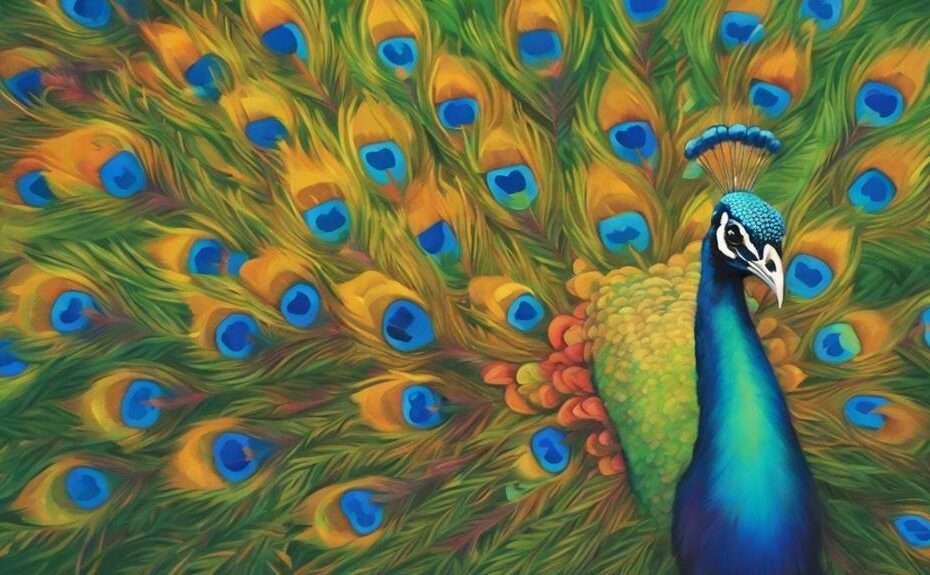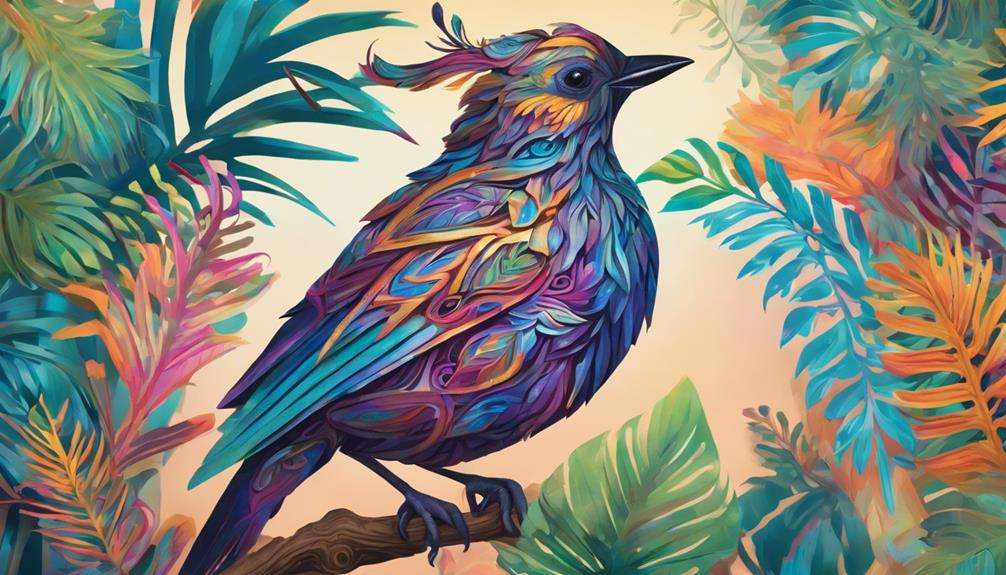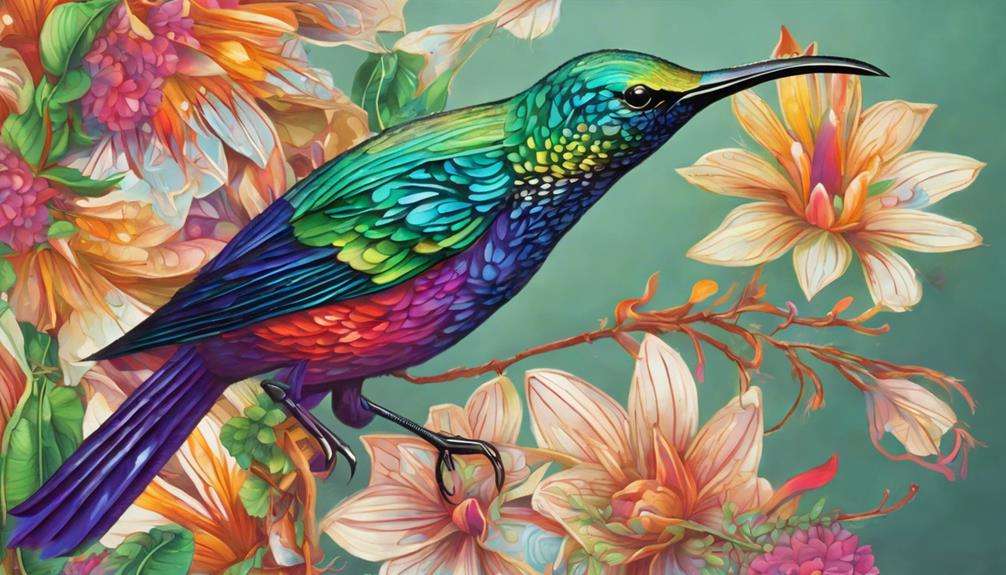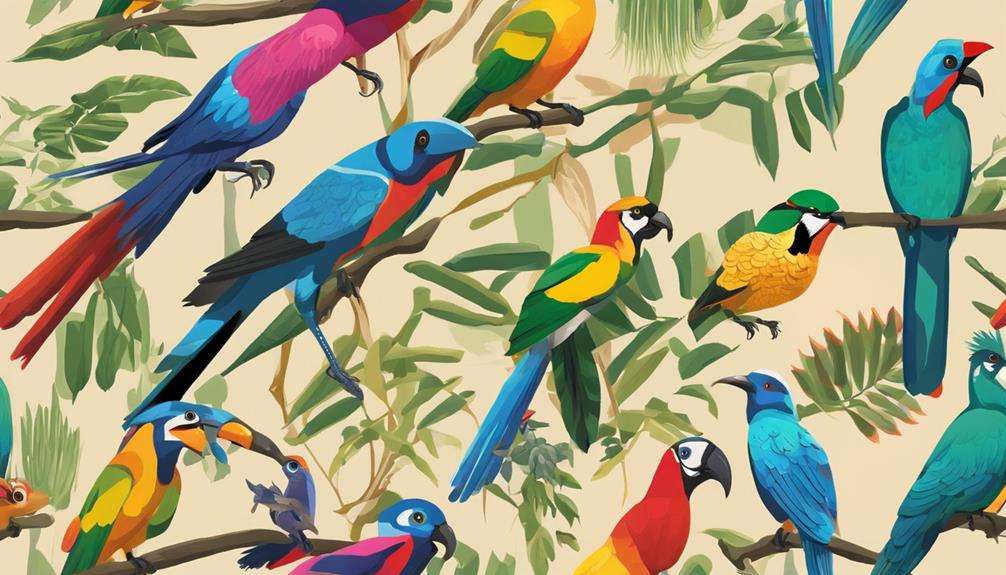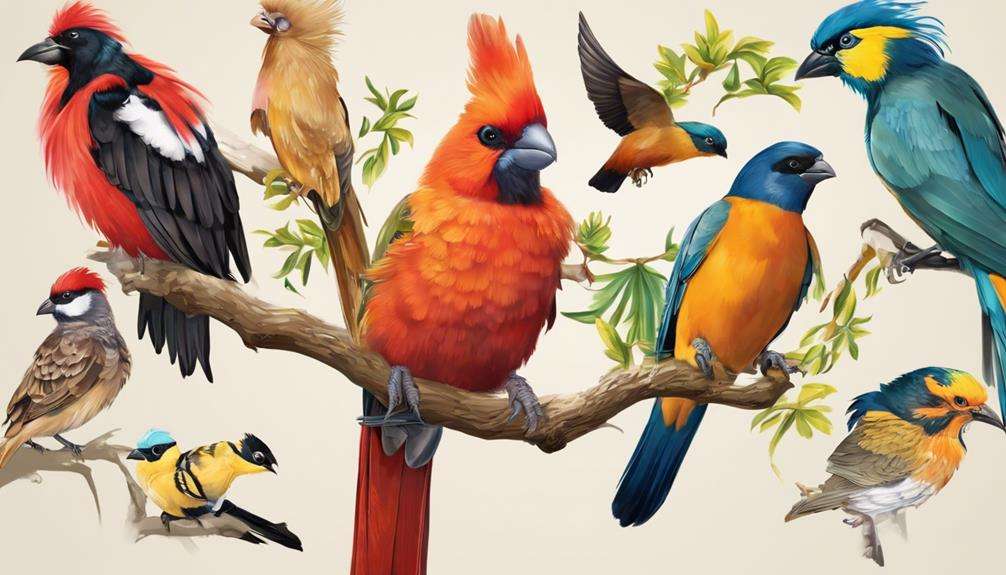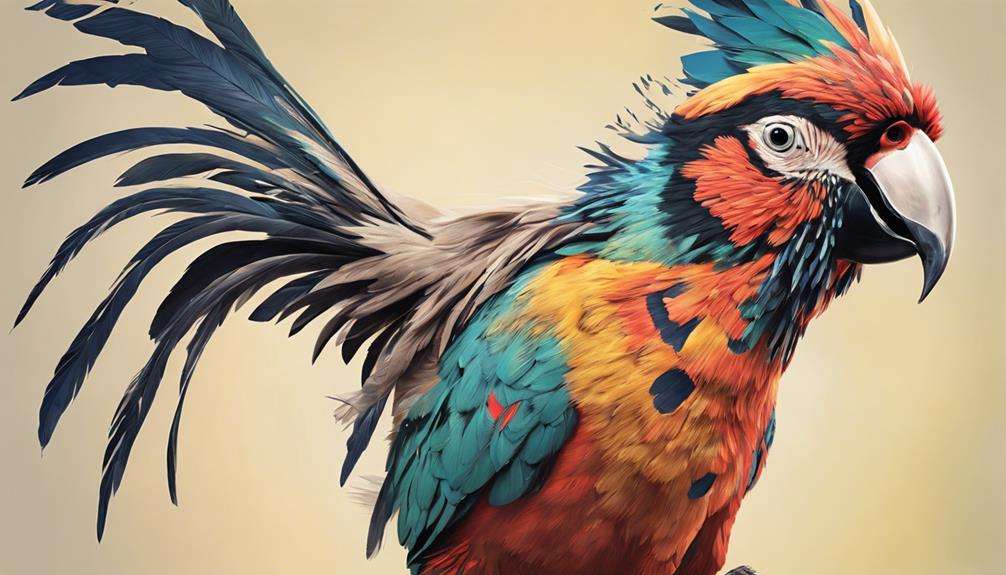You may find yourself marveling at the astonishing beauty of these birds, wondering what secrets lie behind their visually striking appearances.
From the vibrant hues of their plumage to the intricate patterns adorning their feathers, each avian species seems to hold a unique story waiting to be unraveled.
But what drives these birds to showcase such extraordinary features, enchanting the eyes of all who behold them?
Perhaps there is more to their stunning looks than meets the eye, a hidden world of evolutionary wonders just waiting to be explored.
Key Takeaways
- Avian plumage aids in camouflage, courtship, and communication.
- Unique feather evolution shapes vibrant colors and patterns.
- Courtship displays demonstrate health, genetic quality, and species recognition.
- Plumage's cultural symbolism reflects beauty, creativity, and historical significance.
Rare Birds With Vibrant Plumage
Rare birds with vibrant plumage captivate observers with their stunning colors and intricate patterns, making them a sight to behold in their natural habitats. When focusing on a single, low-light environment, such as the dense canopies of the cloud forests in Central America, the Resplendent Quetzal stands out with its iridescent green and red feathers. These colors shimmer even in the dim light, creating a mesmerizing spectacle for those lucky enough to catch a glimpse of this elusive bird.
Similarly, in the sub-Saharan regions of Africa, the Lilac-Breasted Roller showcases a vivid combination of lilac, blue, and green feathers. Even in low light conditions, the striking hues of this bird remain prominent, adding a splash of color to the savannah landscapes. This unique coloration serves both aesthetic and functional purposes, aiding in camouflage and attracting potential mates during courtship displays. Observing these rare birds with vibrant plumage in their natural habitat truly highlights the wonders of nature's artistry.
Birds With Unique Feather Patterns
Birds exhibit a diverse array of unique feather patterns, each serving specific functions in their daily lives and interactions within their ecosystems. Feather evolution has played a vital role in shaping these patterns, leading to the development of striking iridescence effects in many bird species. This iridescence, caused by the microscopic structure of feathers, can create dazzling displays of color when light is reflected off them, aiding in courtship rituals and signaling health and vitality.
In addition to iridescence, feather patterns also play a significant role in signaling dominance within bird populations. Elaborate plumage, such as that seen in peacocks and birds of paradise, is often used to attract mates and establish social hierarchies. These intricate patterns serve as visual cues for potential partners, indicating genetic fitness and the ability to provide offspring with good genes. By evolving these unique feather patterns, birds have developed effective strategies for communication, camouflage, and survival in their diverse habitats.
Exotic Birds With Unusual Bill Shapes
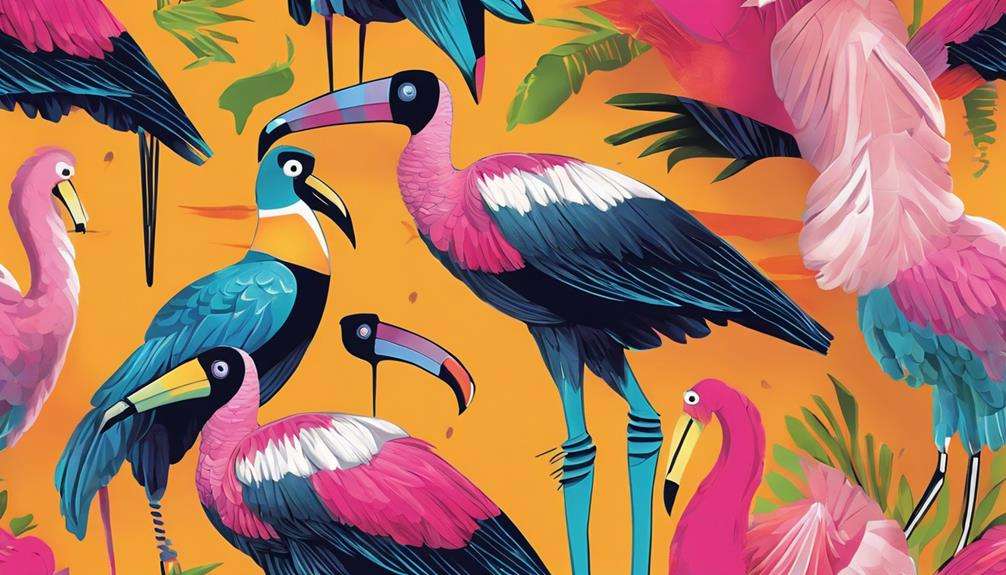
With bills adapted to specific ecological niches, exotic birds exhibit a remarkable diversity of unusual shapes and functions. The Sword-billed Hummingbird stands out with a bill longer than its body, perfectly suited for feeding on long tubular flowers. This unique adaptation allows it to access nectar sources that other hummingbirds can't reach.
On the other hand, the Toco Toucan's large and colorful bill serves multiple purposes, aiding in reaching fruits and regulating body temperature through heat exchange. The Crossbill's bill, with its uniquely crossed tips, enables the bird to extract seeds from conifer cones with precision, showcasing an evolutionary advantage in seed extraction.
Similarly, the Roseate Spoonbill's spoon-shaped bill is specialized for filtering food like shrimp and fish from shallow waters, highlighting an adaptation for its feeding strategies. Lastly, the Curved Bill Thrasher's distinctive curved bill plays an important role in probing the ground for insects and small prey, demonstrating how bill adaptations provide evolutionary advantages in acquiring food resources efficiently.
Colorful Birds With Elaborate Courtship Displays
Colorful birds with elaborate courtship displays exhibit intricate behaviors to attract mates. These behaviors include vibrant plumage displays and complex courtship dances. They are important in showcasing the health, fitness, and genetic quality of the displaying bird, ultimately aiding in pair bond formation and reproductive success.
The bright colors and intricate courtship rituals are essential for species recognition and mate selection in these visually striking birds.
Courtship Dance Behaviors
Elaborate courtship dances in visually striking avian species often involve intricate movements, vocalizations, and displays of colorful plumage to attract potential mates and demonstrate reproductive fitness. These behaviors hold significant pivotal significance as they showcase behavioral adaptations that have evolved over time to increase reproductive success.
The social dynamics within these courtship displays are vital for pair bonding and mate selection, ensuring the continuation of the species. The aesthetic appeal of these dances not only captivates observers but also serves an ecological function by maintaining genetic diversity and strengthening the overall health of the population.
Through species-specific rituals and dynamic displays, colorful birds effectively communicate their suitability as mates, reinforcing their place in the intricate tapestry of nature.
Vibrant Plumage Displays
Male birds often exhibit vibrant plumage with intricate patterns and colors to attract mates during their courtship displays. This showcases genetic fitness and health for species recognition and mate selection. Evolutionary advantages are tied to these displays, as they increase mating success by indicating the male's ability to acquire resources and resist diseases.
Pigment production plays a vital role in creating these vibrant colors, with carotenoids being a common pigment that reflects light and attracts females. Color perception in birds is finely tuned, allowing them to distinguish between subtle shade variations that signal genetic diversity.
Environmental influences such as diet can affect the intensity of colors displayed, with birds in better conditions often exhibiting brighter plumage to demonstrate their suitability as a mate.
Rare Avian Species With Striking Markings

You'll be fascinated by the intricate feather patterns and contrasting colorful plumage of rare avian species with striking markings.
These birds exhibit a unique combination of hues and markings that set them apart in the avian world.
Their vibrant colors and striking patterns make them a mesmerizing sight for any bird enthusiast.
Unique Feather Patterns
The unique feather patterns of rare avian species with striking markings contribute greatly to their visual appeal, showcasing a diverse range of colors and intricate designs. Feather coloration in these birds serves as an evolutionary adaptation, aiding in avian camouflage and visual communication.
The bold black and white stripes of the Harpy Eagle, the iridescent green plumage of the Resplendent Quetzal, and the vibrant mix of turquoise, orange, and white feathers of the African Pygmy Kingfisher all play a role in species recognition within their habitats. These intricate patterns, such as the distinct facial mask of the Harpy Eagle or the bright blue, yellow, and black combination of the Wilson's Bird-of-Paradise, not only make these birds visually striking but also help them stand out among other avian species.
Colorful Plumage Contrast
The remarkable plumage contrast observed in rare avian species with striking markings serves as a visual proof to the intricate evolution of coloration for communication and reproductive purposes.
Species like the Resplendent Quetzal and Wilson's Bird-of-Paradise exhibit vibrant colors to enhance their breeding success through courtship displays. These vibrant hues play a pivotal role in species recognition and are often used to attract potential mates or establish dominance within their communities.
The evolutionary significance of these striking colors lies in their ability to convey valuable information about the health, genetic quality, and fitness of individuals, ultimately influencing breeding success.
Through the development of these visually striking appearances, these birds have adapted to effectively communicate and participate in courtship rituals essential for their survival and propagation.
Birds With Unconventional Physical Features
Nestled within the diverse avian kingdom are birds exhibiting unconventional physical features that captivate and intrigue observers. These evolutionary marvels include wing adaptations like the Hoatzin's claws, reminiscent of prehistoric traits. The Long-Wattled Umbrellabird showcases an extraordinary long wattle used in unconventional courtship displays, a spectacle of nature's creativity. In contrast, the Resplendent Quetzal's vibrant green and red plumage symbolize freedom and wealth in Mesoamerican cultures, blending beauty with cultural significance.
Moving on, the Secretary Bird's remarkably long legs, adapted for ground hunting, are likened to a secretary's quill behind its ear, a modern marvel of adaptation. Similarly, the Andean Cock-of-the-Rock's bright orange plumage and fan-shaped crest play important roles in attracting mates during courtship rituals, demonstrating the fusion of prehistoric traits with contemporary courtship strategies. These birds with unconventional physical features not only offer insights into evolutionary adaptations but also serve as interesting examples of nature's boundless creativity.
Exotic Pets: Avian Species Worth Noting
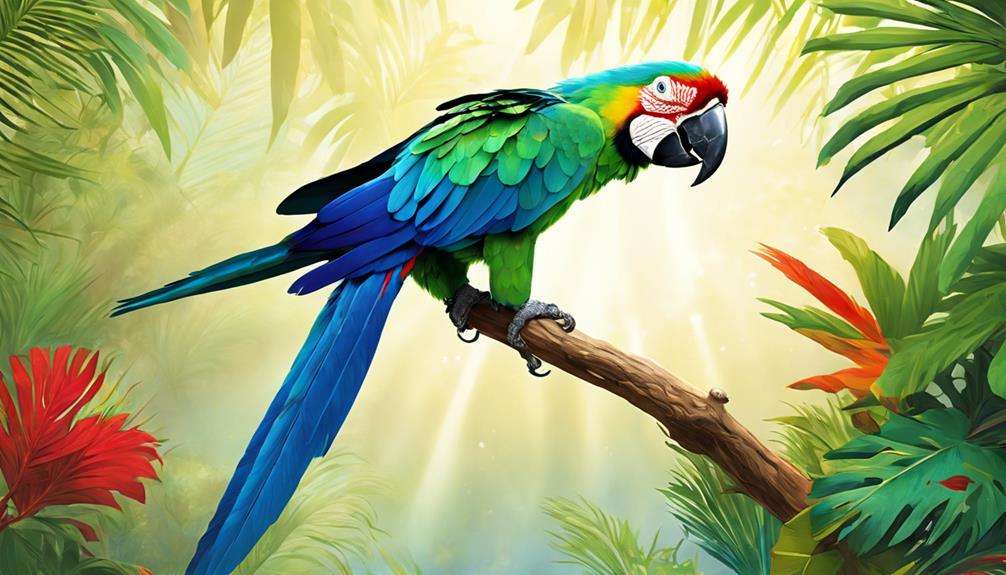
Exotic avian species prized for their vibrant plumage and unique personalities include Macaws, Eclectus Parrots, and African Greys.
The Hyacinth Macaw, the largest parrot species, fascinates with its stunning cobalt-blue feathers and playful demeanor.
Eclectus Parrots exhibit extreme sexual dimorphism, with males displaying bright green plumage and females showcasing striking red and blue colors.
African Grey Parrots, known for their exceptional intelligence and ability to mimic human speech, stand out with their distinctive gray feathering and red tails.
These birds not only dazzle with their feather coloration but also enchant with their avian personalities, from the Macaw's sociability to the Eclectus Parrot's gentle nature and the African Grey's inquisitive behavior.
The visual appeal of these avian companions is further enhanced by their brilliant colors, intricate patterns, and captivating behaviors, making them highly sought-after exotic pets for bird enthusiasts seeking both beauty and charm in their feathered companions.
Frequently Asked Questions
Why Are the Birds Flying Around Like Crazy?
You're witnessing a mesmerizing display of bird behavior as they fly around like crazy! Their flight patterns are a result of intricate group dynamics, with starlings coordinating movements to share warmth and reduce predator risk.
Why Does the Murmuration Happen?
Murmurations occur as a natural phenomenon where starlings exhibit mesmerizing patterns through synchronized movements. Environmental triggers prompt collective behavior, fostering communication signals. The absence of a leader results in decentralized coordination, creating the mesmerizing spectacle of murmurations.
Why Do Birds Swirl in the Air?
You swirl in the air, showcasing mesmerizing aerial acrobatics. This behavior stems from natural instincts and group behavior. Your synchronized movements serve purposes like warmth, safety, and predator confusion, highlighting the intricate social and survival benefits of this phenomenon.
What Is a Flock of Birds Circling in the Sky?
A flock of birds circling in the sky is a mesmerizing display of bird behavior. Their aerial acrobatics create a natural spectacle, showcasing their coordination and synchronization. Witnessing a murmuration is truly a breathtaking sight in nature.
Conclusion
To sum up, the visually striking features of birds serve various purposes, from attracting mates to maintaining social cohesion.
Have you ever wondered how these intricate displays evolved over time, shaping the diverse array of avian species we see today?
The unique plumage, feather patterns, bill shapes, and courtship behaviors of birds reflect the fascinating adaptations that have emerged through evolution, making them a mesmerizing subject of study in the natural world.
